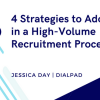The pros and cons of onshoring, offshoring and nearshoring.
AI is taking the market by storm. It’s everywhere. When you call customer service and end up “speaking” with chatbots or get recommendations based on past buying habits, it’s AI at work. In financial services it’s helping specialists run risk models; enabling telecom to build Self-Optimizing Networks (SONs) that automatically improve network quality based on traffic information; and helping manufacturers predict which medical devices may have defects before they can impact patient health.
In short, AI gives all types of organizations the insight and competitive edge they need to be successful in today’s marketplace. Many years ago, Marc Andreesen famously said that software is eating the world, prompting every company to become a software company. Well, today AI is eating the world and every company will soon become AI driven, but it won’t be an easy task.
It’s Tough To Go It Alone
The barriers to becoming an AI-infused company are high. To compete, companies must hire high-level data scientists to design algorithms enabling AI programs to find patterns in the data, as well as data engineers to aggregate, prepare and manage the vast quantities of data that these programs require. These are labor-intensive and ongoing tasks require a major commitment of time, energy and resources. Rather than being a one-and-done development cycle, data scientists need to continually modify, fine tune and create new algorithms to increase the accuracy of AI programs. And it’s no easy feat to find staff who are experts, given the global shortage of data scientists and data engineers.
Companies undertaking AI for image recognition programs have the added task of obtaining and managing crowds of people to identify images. While there are public datasets of images available, private crowds are more accurate and reliable, but can be time-consuming for most companies to handle, as well as a major distraction that can take them away from their core businesses.
Additionally, handling AI development in house requires a major investment in infrastructure. Advanced and expensive GPU processors are required to crunch the massive amount of data that is required – a costly undertaking for many organizations.
Given all of these challenges, it makes sense for most companies to outsource AI development and fortunately there are AI experts available to handle the job. The question is how to select the right outsourcing model - onshoring, offshoring or nearshoring.
Here are the different types of service providers and what they offer:
Onshorers
These service providers are located in the same country as their customers and usually on the mainland. While they share the same language, customs and business understanding, which help increase the accuracy and impact of AI programs, their services are typically available at a premium price of about 30 to 50% higher than offshorers and nearshorers.
Traditional Offshoring Providers
One of the benefits of using offshorers is the cost savings. However, because these organizations are located in other countries, typically very far away from their customers, it could impact effective collaboration. And when it comes to AI, the challenge is in finding a provider who not only has highly skilled data scientists who are experienced AI developers, but who also can address specific, isolated business problems that are important to companies and the highly nuanced, targeted cultural requirements that AI entails.
Nearshoring Providers
Nearshorers, are located close to the shores of their customers – in this case U.S. firms – offer similar cost advantages as offshorers, which are about 30 to 50% lower than onshorers, as well as the added benefit of proximity. They are typically on the same time zones as their customers, making them more readily available for onsite meetings and enabling better communication. Because they are located close to the U.S. they often can understand the language and customs better than offshorers, which helps them develop AI programs that better address the business needs of their customers and chatbots that can mimic actual conversations.
One way to have the best of both worlds – the knowledge and business understanding of onshoring and the cost benefits of nearshoring – is to nearshore to a U.S. Territory, such as Puerto Rico or the U.S. Virgin Islands. The proximity to mainland U.S. makes these ideal locations for nearshoring. In addition, one of the added benefits of nearshoring to these locations is that the residents are U.S. citizens, making them eligible to work on defense and other classified activities that are restricted to U.S. citizens. Also, because there is no need for passports or visas, these nearshorers can easily visit mainland U.S. customers as needed on a moment’s notice.
Because the workers in Puerto Rico and the U.S. Virgin Islands are U.S. citizens, they share the same language, culture and work ethic as their customers, making it easy for them to collaborate and deliver on expectations. These service providers have highly skilled staff – including many graduates from mainland U.S. universities – and offer technical expertise on par with other U.S. professionals.
AI will soon eat the world and if companies don’t rise quickly to meet the challenge, they could become consumed. Fortunately, there are several routes to fast track AI initiatives – and the best ones are closer than you think.
Region:







